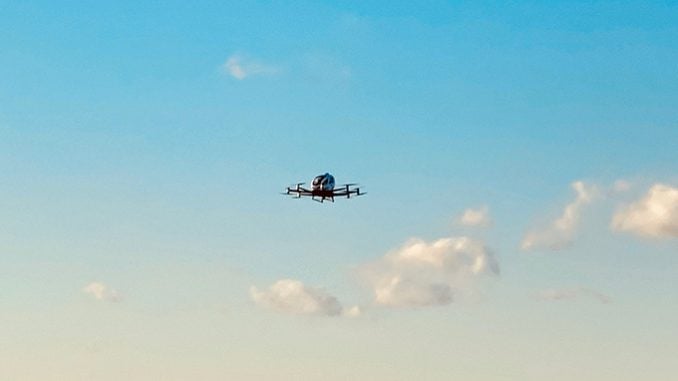
RALEIGH — “It’s the year 2000, but where are the flying cars? I was promised flying cars. I don’t see any flying cars. Why?” asked actor Avery Brooks in what was to become an iconic IBM commercial.
Flying cars are not quite here yet, but the possibility just took a big step forward with the demonstration in Raleigh of an autonomous aerial vehicle (AAV) in front of 100 spectators, including Gov. Roy Cooper, Lt. Gov. Dan Forest and Transportation Secretary Jim Trogdon.
“This changes the face of the world in transportation,” said Forest. “I think it’s the wave of the future, and I think North Carolina should be a key player in this.”
The first of its kind flight took place on Jan. 7, the day prior to the kick-off of the North Carolina Transportation Summit hosted by the North Carolina Department of Transportation (NCDOT).
“Flight started in North Carolina over 100 years ago,” said Trogdon in a press release. “So, it is appropriate the demonstration of this cutting-edge, disruptive technology takes place in North Carolina.”
The craft is a fully automated two-seat passenger-grade AAV, the EHang 216, which can carry two adults on pre-programmed flight routes. The Ehang 216 was in the air five-to-10 minutes over the State Highway Patrol Facility/Aviation Hangar in Raleigh.
“Our mission is to make safe, autonomous, and eco-friendly air mobility accessible to everyone and this trial flight represents a significant step towards bringing our urban air mobility solutions to the U.S. market,” said EHang co-founder, chairman, and CEO Huazhi Hu in a release.
EHang’s other co-founder, Derrick Yifang Xiong, has a connection to the Tarheel state, having earned his master of management degree from Duke in 2013.
According to the literature on the EHang 216, the AAV is designed “100% with green technology and is powered by electricity only.” The AAV has redundant and fail-safe systems in place to ensure safety of the passengers as well as encrypted communications with each AAV having its own independent key.
The company says they have safely conducted over two thousand trial flights in China, Austria, the Netherlands, Qatar, and now, the United States.
“Pilotless air taxis have the power to transform everyday life in urban areas since they can lessen pollution, expedite emergency services, and save individuals and businesses time and money through shorter travel times,” Hu said.
EHang has three market areas in play with urban air mobility, smart city management, and aerial media. The company supports their products with a set of operational service supports, including training, maintenance, command-and-control system set-up, and flight monitoring.
Other companies besides EHang have projects involving autonomous drones and flight vehicles like the air taxi. Big names like Airbus and Boeing have both been testing their own prototypes in the last few years.
The ride-sharing company Uber, in cooperation with vehicles produced by Hyundai, is working on an air taxi prototype of their own.
The vehicle is being called an S-A1. It has four seats, four propellers and is also an electric vehicle. According to the specifications, the craft will cruise at up to 180 miles per hour at an altitude of 1,000 to 2,000 feet above the ground and can travel as far as 60 miles. Both companies are hoping to have the prototype ready sometime in 2023.

